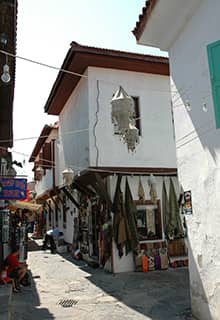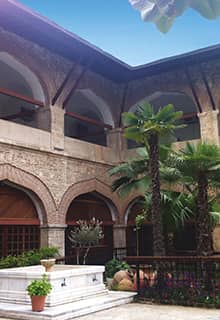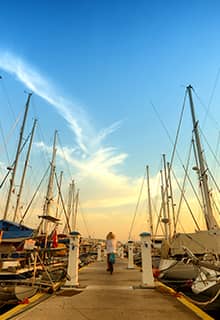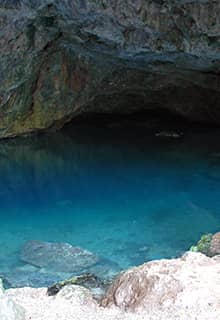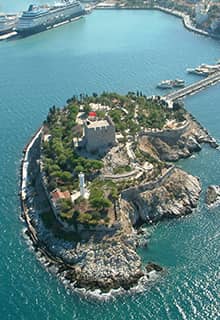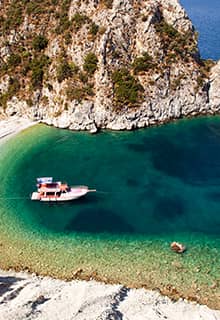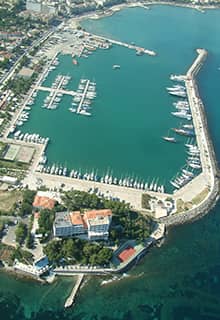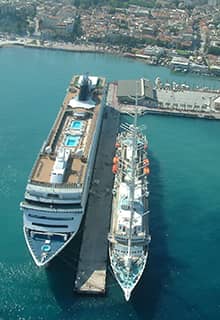

see
Kuşadası
The streets of Kaleiçi and the Kaleiçi Bazaar
When the city was built in the 16th century, it had three gates and was surrounded by caravansaries and city walls. Of these historical gates, one has survived to the present day, welcoming visitors in its imposing glory on a walking path from the port. Enter the gate and you will find yourself amid narrow, winding streets lined with bars, cafes, shops and restaurants. The historical Kaleiçi Bazaar features numerous shops selling carpets, leather, textiles and souvenirs, with a background of live music emanating from the surrounding restaurants and bars.
In Kaleiçi, visitors will also find the Kaleiçi Mosque, Kaleiçi Bath, and the Historical Kaleiçi Walls. Set in the centre of Kuşadası, Kaleiçi attracts attention as a site where history stands alongside modern shopping, dining and entertainment.
Öküz Mehmet Paşa Caravanserai
Erected by Grand Vizier Öküz Mehmet Paşa in the 17th century, the building is opposite the Kuşadası Port.
Around its rectangular courtyard surrounded by thick, high walls is a two-story portico entrance. The caravanserai, with an appearance similar to a small castle, has rooms that face into a large courtyard. The historical building is now used as an exhibition and event area; it also features a hotel and a shopping facility.
Kaleiçi Mosque
The mosque, built by Öküz Mehmet Paşa in 1618, underwent extensive repairs in 1830. It is set in the castle, with its minaret visible from the caravanserai. The mosque draws attention with a dome set atop a structure with 12 arched windows, and its magnificent entrance with geometric plates.
Micro Miniature Museum
The third micro miniature museum in the world and the first in Türkiye, the museum. is 50 meters from the Kaleiçi Mosque (Kaleiçi Cami), and on the second floor of the entrance to the city, which is still standing. The artworks can be observed with a microscope.
Güvercinada Castle
Set on the tiny island of Güvercinada at the mouth of Kuşadası Bay, Güvercinada Castle (Güvercinada Kalesi) was erected to protect the harbour. Built by the famous sailor, Barbaros Hayrettin Paşa, the castle is on the tentative list of UNESCO World Heritage Sites. For centuries, Güvercinada was important for the region due to its location. The history of the castle, renovated during the Ottoman period, dates from the Genoese who arrived in Kuşadası at the beginning of the 14th century.
Set south of the cruise port, the castle is connected to the mainland by a breakwater. It welcomes visitors with its historical atmosphere on Güvercinada, which the renowned travel writer Evliya Çelebi referred to as a “talismanic islet that birds definitely visit”.
The island is a 10-minute walk from the Kuşadası centre. Along the way, visitors can swim in the small bay at the beginning of the road for free, relax in the cafes and restaurants and enjoy the view.
Dilek Peninsula National Park
Dilek Peninsula (Dilek Yarımadası), where mountain, sea, and forest meet, features breath-taking vistas of blue and green. You can follow Davutlar town to reach Dilek Peninsula National Park (Dilek Yarımadası Milli Parkı), a stunning location with magnificent nature, wonderful beaches and pristine seas. The peninsula is part of the Büyük Menderes Delta.
A pathway, surrounded by endemic plants, leads to the Cave of Zeus and four different beaches. If you arrive by sea, you’ll be greeted by heavenly bays, ideal for swimming, diving, or boat tours.
Dilek Peninsula National Park has hundreds of bird species, along with underwater, historical and cultural diversity. Activities on the peninsula include angling, cycling, trekking, and wildlife and bird watching. Dilek Peninsula is home to 250 species of birds. The Menderes Delta, considered an Important Bird and Biodiversity Area, is part of a bird research observation program and 70 species of birds were bred. The Observation Terrace draws photography enthusiasts with its nature and splendid views.
The park features a canyon, the steep Kaya Valley, small streams, and dense vegetation and paths, making it a superb trekking trail for extreme sports enthusiasts.
Due to its unique biological diversity, Dilek Peninsula was also accepted as a “Flora Biogenetic Reserve Area” by the Council of Europe. Dilek Peninsula was declared a National Park in 1994.
Cave of Zeus
It is believed that this cave, 100 meters from Dilek Peninsula National Park, was where Zeus sought refuge from the wrath of Poseidon. There is a shallow lake in the cave: both Aphrodite and the Virgin Mary are alleged to have bathed here. The cave is 60 meters long, 20 meters wide and 10 meters deep. Its annual average temperature is 5 C.
Marina
North of the Cruise Port and within walking distance to the city centre, the marina (yat limanı) has 428 boat slips and a capacity for 130 boats in dry storage. The marina is a popular spot for sailboats, particularly during the winter. Its location in the centre of Kuşadası is particularly attractive, as it is close to restaurants and bars, as well as the Marina Bazaar, featuring alternative brands.
Cruise Port
With its historical heritage, the Kuşadası Cruise Port (Kruvaziyer Limanı) has served cruise ships for decades and continues to welcome millions of visitors with Turkish hospitality. In addition to comprehensive terminal, maritime and auxiliary services, the port offers the highest level of comfort to passengers and crews in its modern passenger terminal.
Kadınlar Beach
The most famous beach of Kuşadası, Kadınlar Beach (Kadınlar Plajı), is 3 km from the district centre. The Blue Flag beach is 1 kilometre long and easily accessible via public transportation departing from the centre. Sunbeds are available to rent at the beach.
Davutlar Beach
Set at a point where blue sea and pristine forest meet, Davutlar Beach (Davutlar Plajı), in Davutlar town, is 19 kilometres from Kuşadası. The beaches and hiking paths of the natural park within the regional border offers visitors an alternative holiday opportunity.
Oleatrium - Olive Oil Museum and Farm
About a 20-minute drive from the centre of Kuşadası, the Oleatrium – which means Olive Courtyard – is a delightful museum that takes visitors through the culture of olive cultivation and olive oil. The Oleatrium - Olive Oil Museum (Oleatrium - Zeytinyağı Müzesi), opened in Kuşadası in 2011, is a valuable resource that examines the role of olives in the history of Anatolia and the Mediterranean and sets out steps for the future. The museum features exhibit on the technologies developed in the production of olive oil in historical order from 2000 BCE to the present, with the various usage areas of olive oil narrated in lively, animated stories; visitors can witness how olive oil proceeds from the production stage to the table.
At the entrance of the museum, there is a market where you can buy souvenirs, olive oil and wine.
Historic Kuşadası Houses
Featuring houses with ornate, tile-covered roofs and clean cobblestone streets, Kuşadası’s urban texture includes surprising slopes and narrow, winding streets – some with stairs. These streets, lined with the Kuşadası Historical Houses (Tarihi Kuşadası Evleri), reflect the cultural diversity of the city in the 19th century and invite visitors to a walk in the corridors of history.
The houses have ornate woodwork, guillotine joinery windows, and crescent and star motifs, reflecting the Turkish identity, atop the windows. Some have the bird motifs that characterize Kuşadası.
The plant and animal motifs used on many houses have been enriched over time; stylized flower, leaf and bird motifs were frequently used in the Kuşadası houses and are among their distinguishing features.

